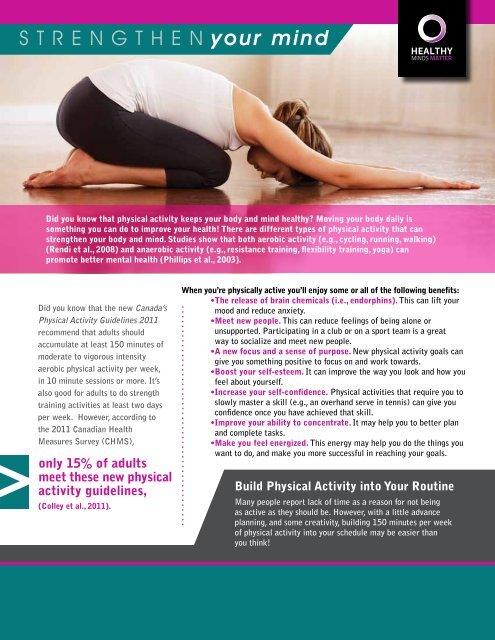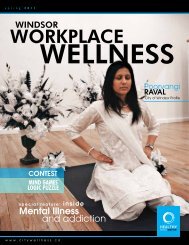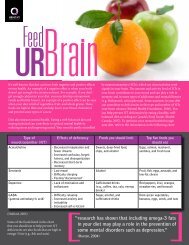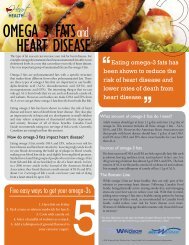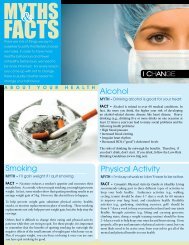Strengthen Your Mind (pdf) - City of Windsor Wellness
Strengthen Your Mind (pdf) - City of Windsor Wellness
Strengthen Your Mind (pdf) - City of Windsor Wellness
Create successful ePaper yourself
Turn your PDF publications into a flip-book with our unique Google optimized e-Paper software.
<strong>Strengthen</strong>your mind<br />
Did you know that physical activity keeps your body and mind healthy Moving your body daily is<br />
something you can do to improve your health! There are different types <strong>of</strong> physical activity that can<br />
strengthen your body and mind. Studies show that both aerobic activity (e.g., cycling, running, walking)<br />
(Rendi et al., 2008) and anaerobic activity (e.g., resistance training, flexibility training, yoga) can<br />
promote better mental health (Phillips et al., 2003).<br />
Did you know that the new Canada’s<br />
Physical Activity Guidelines 2011<br />
recommend that adults should<br />
accumulate at least 150 minutes <strong>of</strong><br />
moderate to vigorous intensity<br />
aerobic physical activity per week,<br />
in 10 minute sessions or more. It’s<br />
also good for adults to do strength<br />
training activities at least two days<br />
per week. However, according to<br />
the 2011 Canadian Health<br />
Measures Survey (CHMS),<br />
only 15% <strong>of</strong> adults<br />
meet these new physical<br />
activity guidelines,<br />
(Colley et al., 2011).<br />
When you’re physically active you’ll enjoy some or all <strong>of</strong> the following benefits:<br />
•The release <strong>of</strong> brain chemicals (i.e., endorphins). This can lift your<br />
mood and reduce anxiety.<br />
•Meet new people. This can reduce feelings <strong>of</strong> being alone or<br />
unsupported. Participating in a club or on a sport team is a great<br />
way to socialize and meet new people.<br />
•A new focus and a sense <strong>of</strong> purpose. New physical activity goals can<br />
give you something positive to focus on and work towards.<br />
•Boost your self-esteem. It can improve the way you look and how you<br />
feel about yourself.<br />
•Increase your self-confidence. Physical activities that require you to<br />
slowly master a skill (e.g., an overhand serve in tennis) can give you<br />
confidence once you have achieved that skill.<br />
•Improve your ability to concentrate. It may help you to better plan<br />
and complete tasks.<br />
•Make you feel energized. This energy may help you do the things you<br />
want to do, and make you more successful in reaching your goals.<br />
Build Physical Activity into <strong>Your</strong> Routine<br />
Many people report lack <strong>of</strong> time as a reason for not being<br />
as active as they should be. However, with a little advance<br />
planning, and some creativity, building 150 minutes per week<br />
<strong>of</strong> physical activity into your schedule may be easier than<br />
you think!
Ways to get moving<br />
Examples<br />
Get your heart pumping doing daily tasks.<br />
Add a little intensity when you’re vacuuming or cleaning<br />
your house.<br />
Plan ahead.<br />
Keep your walking shoes at work and walk during lunch<br />
hour or break. Pack a simple and healthy lunch so you’ll<br />
have extra time to walk during your lunch hour.<br />
Join or create an exercise group.<br />
Start a walking group which walks at a regular time during<br />
the day. Look into mall walking groups during the winter<br />
months.<br />
Choose physical activity classes that are available in your community. Local community centres now <strong>of</strong>fer a variety <strong>of</strong> classes<br />
(e.g., yoga, badminton, dance).<br />
Choose activities that don’t need a gym or equipment. Try walking outside or turn on the music and dance for 10<br />
minutes when inside.<br />
Set realistic goals.<br />
Start walking 10 to 15 minutes at a time, three times a day.<br />
Slowly increase your goal to build 150 minutes <strong>of</strong> physical<br />
activity per week.<br />
Take time for yourself and refresh your mind.<br />
Take a break at work or home and do something to be<br />
physically active.<br />
Make moving a part <strong>of</strong> your routine.<br />
If weather permits, park at the far end <strong>of</strong> the parking lot.<br />
When possible, use the stairs instead <strong>of</strong> the elevator.<br />
Take on activities that you enjoy.<br />
If you really like to swim, then include swimming in your<br />
activity plan.<br />
Stick With It!<br />
Once you begin a physical activity routine, sticking with it<br />
can be a challenge. Some things that you can do to help you<br />
stay on track are:<br />
•Remind yourself <strong>of</strong> the reasons why you<br />
started in the first place.<br />
•Be aware <strong>of</strong> the positive feelings that you have<br />
as a result <strong>of</strong> being active daily.<br />
•Get support. Be active with friends, co-workers<br />
or family. Someone who supports you and your<br />
goals.<br />
•Record your success. In your monthly calendar,<br />
write down every time you are active, what you<br />
did, and how you felt.<br />
•Imagine yourself reaching your goal. Picture<br />
yourself finishing the charity walk that you<br />
entered, or fitting into your favourite jeans.<br />
•Restart your engine. If something forces you<br />
to stop being active, don’t let it get you down.<br />
Instead, start moving again when you’re able to.<br />
Moving Forward<br />
By moving your body every day, you can strengthen your body<br />
and mind. By being active, you can also lower your risk <strong>of</strong> heart<br />
disease, certain types <strong>of</strong> cancer, diabetes, and depression. So, do<br />
the best thing you can for your health and build physical activity<br />
into your day, every day.<br />
For more information on<br />
physical activity, visit these<br />
websites:<br />
-<strong>Mind</strong>ing Our Bodies: Physical activity for<br />
mental health at www.mindingourbodies.ca<br />
-Canada’s Physical Activity Guide<br />
www.csep.ca/english/view.aspx=804<br />
References:<br />
Colley, R.C., Garriguet, D., Janssen, I., Craig, C.L., Clarke, J., & Tremblay, M. S. (2011). Physical<br />
activity <strong>of</strong> Canadian adults: Accelerometer results from the 2007 to 2009 Canadian Health<br />
Measures Survey (Catalogue no. 82-003-XPE). Health Reports, 22 (1), 1-8. Retrieved<br />
September 20, 2010 from the Statistics Canada website: http://www.statcan.gc.ca/pub/<br />
82-003-x/2011001/article/11396-eng.htm<br />
Phillips, W.T., Kiernan, M., & King, A.C. (2003). Physical Activity as a Nonpharmacological Treatment<br />
for Depression: A Review. Complementary Health Practice Review, 8(2): 139-152.<br />
Rendi M., Szabo A., Szabo T., Velenczei A., & Kovacs A. (2008). Acute psychological benefits <strong>of</strong> aerobic<br />
exercise: A field study into the effects <strong>of</strong> exercise characteristics. Psychology, Health & Medicine,<br />
13(2):180-184. © <strong>Windsor</strong>-Essex County Health Unit, May 2012.


